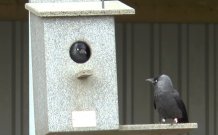
Size of jackdaw mobs depends on who calls warning (Photo credit Victoria Lee)
Angry birds: Size of jackdaw mobs depends on who calls warning
Jackdaws recognise each other’s voices and respond in greater numbers to warnings from familiar birds than strangers, new research shows.
The birds produce a harsh “scolding call” when they spot a predator, calling fellow jackdaws to mob the intruder and drive it away.
University of Exeter researchers have discovered that each bird has a unique call, and the size of the mob depends on which bird calls the warning.
The scientists played recordings of individual calls and found that the largest mobs assembled when birds heard the cry of a member of their own colony.
“Joining a mobbing event can be dangerous, as it involves approaching a predator, so it makes sense for individuals to be selective in whom they join. Our results show that jackdaws use the ability to discriminate between each other’s voices when deciding whether to join in potentially risky collective activities,” said Dr Alex Thornton, of the Centre for Ecology and Conservation on the University of Exeter’s Penryn Campus in Cornwall.
“We also found a positive feedback loop – if birds joining a mob made alarm calls of their own, this in turn caused more birds to join in, magnifying the size of the mob.”
First author Dr Richard Woods said: "This experiment stems from the first data chapter of my PhD and has lead to several very cool experiments within our research group.
"Many hours were spent trying to capture recordings of specific jackdaws, which was often frustrating but very rewarding when the playbacks produced such interesting results."
The researchers studied wild jackdaws, a highly social member of the crow family, as part of the Cornish Jackdaw Project, a long-term study of jackdaw behaviour and cognition in sites across Cornwall.
Michael Kings contributed acoustic analysis that showed the jackdaw alarm calls to be individually distinct, which is a prerequisite of all the patterns of response described in the paper.
In playbacks at nest-box colonies during the breeding season, they broadcast the warning calls of a resident from each nest-box, another member of the same colony, a member of a different colony, and a rook (a species that often associates with jackdaws).
Jackdaws were most likely to respond to a warning from a bird from the resident nest-box owner, followed in turn by other colony members, non-colony members and rooks.
Responses were also influenced by caller sex, with jackdaws less likely to echo a warning if the caller was a female stranger from a different colony.
The paper, published in the journal Scientific Reports, is entitled: “Caller characteristics influence recruitment to collective anti-predator events in jackdaws.”
For more information about the Cornish Jackdaw Project visit www.wildcognitionresearch.com or follow us on twitter @CornishJackdaws
Date: 10 May 2018
